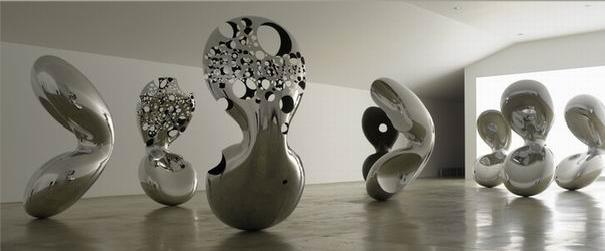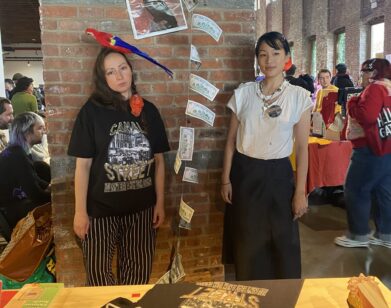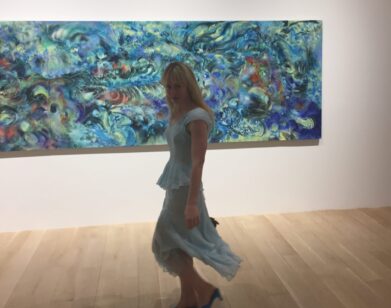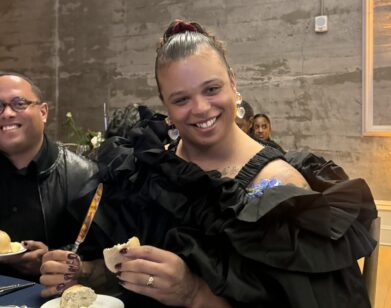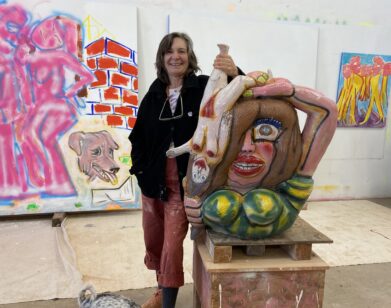Ron Arad
The studio is on Chalk Farm Road in North West London. You enter it by way of a flaky blue gate that opens onto a cobbled lane called Old Dairy Mews. You then climb a steel stair and find yourself, with a dislocating sci-fi effect, inside a bendy, asymmetrical space where, at first glance, the principal occupants are chairs. Then you note that there are assistants sinking into their computer screens, like Alice just before she slips through the looking glass, but they are outnumbered by chairs and models for other projects. A few models are rendered in graphics—one is graffitied Keep The Texture Make Reflective—but mostly they are in the round.
Ron Arad was at the far end, and, as usual, he was wearing a peculiar hat. Its brim was turned up in the front, like the other guy (not Jackie Gleason) in The Honeymooners, or like a Breughel peasant, and it was so well-worn that the round head-hugging part was at once crusty and shiny. Arad was born in Tel Aviv, Israel, in 1951, with both his mother and father working as artists. In 1973, he moved to London to study at the Architectural Association and was tutored by Peter Cook and Bernard Tschumi. In 1981, he set up his own design practice, One Off, with Caroline Thorman, who remains his partner today. Twenty years ago they started Ron Arad Associates in its current location. Arad says that nobody remembers a dairy near Old Dairy Mews—“just sweatshops”—so dairy life must have taken place when they were still farming at Chalk Farm.
Arad designed his first piece of furniture in 1981, a sleekly aggressive postmodernist piece that melded segments of 1930s scaffolding with the seat of a British car, a Rover 2000. The Rover Chair would be the first of a slew of objects and habitable forms that established ARAD as somebody whose eye and hand crossed conventional borders. One example: He has made pieces with Swarovski crystals and leds to receive and display text messages.
Ron Arad is currently the head of the Department of Design Products at London’s Royal College of Art and he is one of the handful of most watched designers today, but he remains vehemently critical of the art world for what he sees as its reluctance to accept anything with even a hint of function in it. That said, he recently enjoyed a solo retrospective at the Centre Pompidou in Paris. The show will open at New York’s Museum of Modern Art on August 2.
ANTHONY HADEN-GUEST: Speaking of design, tell me about the hat.
RON ARAD: About hats in general? Or about this specific hat? HADEN-GUEST: This particular hat. It looks like it comes out of Breughel.
ARAD: Simply, some people have hair, and some people have hats. I wish I belonged to the first group, but I belong to the second. So it’s my hat. Alessi made and distributed 2,000 of them. I walked into a show in Milan and saw somebody wearing it. That was very strange.
HADEN-GUEST: Okay, the Pompidou. You wanted the show to be called “No Discipline”?
ARAD: That is what it’s called.
HADEN-GUEST: I like that.
ARAD: Yeah, I mean, it fits: (A) It’s my temperament; and (B) I don’t subscribe to any discipline. As you can see here, there’s very little demarcation between sculpture, design, architecture, and Ping-Pong. The problem with the French people is they have some rule that they can’t have names that are not in French. So I tried “Sans Disciplin.” I tried “Pas de Disciplin.” Nothing is as good as simply “No Discipline.” Like, no entry! No chance! And I don’t think I’m using words that a Frenchman doesn’t understand.
HADEN-GUEST: Contre Disciplin?
ARAD: I’m not against anything. I’m pro everything. Contre is more negative than no, maybe. Anyway, it seemed to be a good thing to fight over. You get very upset when you get a negative response. And you get quite pleased when you have your way. Which I did.HADEN-GUEST: What’s in the show?
ARAD: The museum wanted me to do a retrospective. Why is design important? What is design? How do you design? We just wanted to show the latest work. I did find a balance, a way to evaluate my language—which is architecture, industrial design, and studio and gallery pieces.
HADEN-GUEST: What do you mean by studio and gallery pieces?
ARAD: Things that are not designed to be sold in shops. And things that are not mass-produced. Things that are not necessarily practical solutions to real problems, but things that are done for their own sake—without considering or negotiating with anything or anyone. So these are the three major areas.
HADEN-GUEST: The show goes to moma next?
ARAD: The show goes to the moma. But it doesn’t go to the moma because the space in the moma is different. The people in the moma are different; the moma has a different approach to things. And also there’s a different curator. Curators want to believe that they influence things. So it’s the same show but a different show. I had to make a presentation to the trustees of the moma and show them the work that I’m doing in Paris. And I made a little film. I can show it to you?
HADEN-GUEST: Yeah!
ARAD: It’s 20 minutes. It’s studio and gallery pieces, industrial design, and architecture. Architecture is not normally a good thing to show in exhibitions, because you never see the real thing. You only see models, drawings, or photos. It’s just something representing something that is somewhere else. So I decided to take one of my old projects and build a one-to-one replica of it. So rather than have a model, I have a reconstruction.
HADEN-GUEST: Same size?
ARAD: Same size. Same everything. It looks the same. The original is the island, the foyer of the Tel Aviv opera house from 15 years ago, a few weeks before computers took over architectural practices. And everyone thought it was a computer project, but no, it was done by hand. And I highlight one project that should be finished soon, which is a design museum outside of Tel Aviv, in Holon. Do you know where Holon is? Most people don’t. It will put them on the map. I came up with a way to combine the structure and the filtering of light all in one. [ARAD starts the movie.]
HADEN-GUEST: When you arrive at these forms, how much of it is intuitive? You’re dealing with real-life elements, like weight and stresses.
ARAD: There are engineers who work on everything you come up with. The thing about this particular museum is that it’s not just a pretty face—it’s a structure. It’s a museum without a single column. [Further images appear onscreen.] This is a house I did in Kenwood, Hampstead, London. This is a project I did for Battersea Power Station . . . That is in Italy . . . This is a shopping mall . . .
HADEN-GUEST: How many of these will be in the show?
ARAD: All of them. But just one real-life structure. And these are the projects that are going to be shown in models on the computer. [Computer simulations appear of projects intended for Les Diablerets, the fiercely fanged mountains that tower over the fancy Swiss resort village Gstaad. One is a commission from the British motor-
racing magnate Bernie Ecclestone.] This is a mountain that was bought by Bernie Ecclestone. My site is there. [An assistant comes up. Another visitor has arrived.] Later!
HADEN-GUEST: This is going to be built?
ARAD: [nonchalantly]Probably. [Another computer simulation of this Alpine utopia appears. It is captioned “Moonshadowsnow.”] This is a Swarovski project. The early sketches had some crystals in them—blown-up crystals. But I went off it very fast. It’s going to be built entirely off-site and helicoptered in. It’s called Camera Obscura, because you can see it upside down, in motion, because the building moves. [A kind of fairground music strikes up. “Hahahaha . . . Hoo-hoo! . . . Hee-haw!” It’s partly jolly, partly jeering, like the ominous clown in a horror movie.]
HADEN-GUEST: What’s that sound? A karaoke yodel?
ARAD: I went on the Internet and looked for a yodel. And I found this. So I played it in reverse. Back and forth. [The yodel fades away. The Alpine projects are replaced by other images.] Now, industrial design . . . You see that piece up there? It’s not about what it looks like. It’s about how it’s done. It’s done by sliding the membrane into two aluminum extrusions. It’s a bit like Chaplin’s Modern Times [1936], you know? [another image] And look at this one! It’s very elastic, and it’s perfectly strong. What you see here is what you get. It’s called Screw. And there are no hidden parts.
HADEN-GUEST: Do you patent your designs?
ARAD: I design mainly for Italian companies and producers. So they do it, they register it. It doesn’t stop people in China. I went to visit some factories in China that make copies. And they probably produce more of my work than what is made in Italy. I had meetings with them. I didn’t fight with them. I thought, How can we help them promote themselves? [Two chairs appear.] I thought I was going to save the world with these [chairs].
HADEN-GUEST: How?
ARAD: Because it’s a slow technique. I felt that doing two at once from just one mold that separates into two chairs would double the speed. But, actually, it slowed it down. I can stop and explain it to you?HADEN-GUEST: Let’s wait until afterward.
ARAD: Okay. This is my first piece of furniture. I didn’t even know I was going to be a designer when I did it. It’s the Rover Chair. And now, 28 years later, we are doing two things: limited-
edition sculptures of it, more or less, and then putting it into production with Vitra. It’s going to be what the new Mini is to the old Mini. [Another chair appears. It looks just like a comfy armchair, except it’s made of steel. But I have sat in one, and I can tell you that it feels just like a comfy armchair too.]
HADEN-GUEST: I know this chair.
ARAD: This is the Well Tempered Chair. It’s made of tempered steel—tempered steel, what an amazing material! It’s steel with no memory. [Another form appears onscreen.] This one started as a component for a sculpture in the center of Milan. And then it was translated into a best-selling piece by Vitra. I know there are about 11 companies in China that produce copies of them. And then there’s the sort of sculpture version of this. So sometimes industrial pieces find themselves translated into studio pieces.
HADEN-GUEST: Nowadays, how do you anticipate what a project is going to look like? Models? Computer simulations?
ARAD: Often now, before we see an object, we can see a film about it, and know exactly how it’s going to be. [The image of a structure appears onscreen. It is captioned “Bodyguards.”]
HADEN-GUEST: Why “Bodyguards”?
ARAD: There is a reason. I did a show one year at Dolce & Gabbana’s Metropol in Milan. It was an old cinema. There were more bodyguards than pieces in the show, and I was sort of mocked by my friends about the number of bodyguards. So when I exhibited there again the following year, to preempt the mocking, I called the show “Bodyguards.” You have to give something a name. Once you call it a bodyguard, it looks a bit like Grace Jones! It’s a piece that I cut and do different things with. The bodyguard theme goes on and on . . . [more images] This is the last Maastricht art fair. You see, that red piece is one of these chairs. So you can see inside . . . This is a piece called Thumbprint, which is pretty amazing, because it’s like a landscape, the general shape, and then when you look closer it has its own fingerprint . . . [another image] This is a table for a collector in L.A.—in Hollywood.
HADEN-GUEST: It’s a word piece?
ARAD: Yes. It had Adolf in the piece. And he said I can’t have the word Adolf in this table. This is an installation in Miami. It was made out of 70 tables. Some of them were bent to go up the wall, and after the installation, each table was going to a different address. So they met only one time in their life . . . And that’s an early installation, in the Fondation Cartier. But here all the tables were identical. [The image of a table appears.] This is at the Bologna art fair. This is a Ping-Pong table. It was in the Royal Academy Summer show. And on the opening day, Anthony Caro told me, “This is marvelous! And we can also play Ping-Pong on it!” But the funny thing is that you couldn’t play in the Royal Academy. [film ends]
HADEN-GUEST: Okay. How were you going to save the world with the two chairs?
ARAD: It was a design situation. There’s a technique called rotational molding. Rotational molding is like making a cake. Having the mold, putting the molten plastic inside, shaking and rotating it, the plastic adheres to the inner surface of the mold. And then you take it out like a cake. Tooling cost is cheaper, but it’s very slow. So that’s why it’s used by young designers, young companies, because they don’t expect to sell that many. So I felt that I make a piece in the mold, and then I cut it into two. And each one is a chair in its own right, then I cut the production time by half. But not so! Because normally when you take a piece out, it’s ready. You don’t have to take it to another side of the factory, stick it in another machine. It’s sort of saving time and a waste of time. You know, it happens that you think you are doing something good and you are actually doing something not so good. Like the guy who invented a “safe” CFC to replace CO2 was the same guy who introduced lead to petrol. He was lauded for his contribution to the environment. And he was the biggest enemy of the environment, the biggest villain. But he was a good man. So I was a good man there!
HADEN-GUEST: Well, Henry Kissinger got the Nobel Peace Prize.
ARAD: So did [Menachem] Begin, with [Mohamed] Anwar al-Sadat.
HADEN-GUEST: When we last had this conversation, we were talking about Art Basel, and you said photography has been accepted into the art world—or, at least, that the art world can decide what is good photography and what isn’t.
ARAD: Right.
HADEN-GUEST: You said that there is no photography ghetto at art fairs. But that there’s still a design ghetto.
ARAD: Uh-huh!
HADEN-GUEST: Do you still feel that?
ARAD: Absolutely! It’s gotten even worse. The thing is that the design ghetto got sort of more established. There’s a design ghetto outside Frieze, another outside Basel, one inside FIAC . . .HADEN-GUEST: What interests me is this: If you go around a fair like Art Basel, there’s a certain amount of boring art—
ARAD: Shall we say 95 percent? Okay?
HADEN-GUEST: Okay. Call it avant-garde salon art. But there’s only 5 percent of really horrible art. Design fairs have some pieces that are really wonderful, but the proportion of bad stuff, it seems to me, is much higher than in art fairs.
ARAD: Well, maybe. Because it’s like with every new bandwagon. You know, there were lots of bad cubist paintings. I mean, there was Braque, Picasso, Gris . . . And then there was a cubist painter in every capital of the world. In every movement you have the people who are real, and you have the people who join in. People are joining in, in a big, big way.
HADEN-GUEST: You’re talking about design art?
ARAD: I’m talking about . . . In every movement, whether you like it or not, at the end of the day it’s about individuals; it’s not about movements. I enjoy doing things for the industry. The thing that I don’t enjoy is that you have to convince people—they have to be convinced. And I’m not into designing just anything. For me, to design something is to do something that was not there before I did it. It gives me . . . I don’t know if you know this PizzaKobra light? [ARAD spins behind my chair to a nearby desk, and returns cradling a flat blackish disk, made from a coil, like an old-fashioned firelighter.]
HADEN-GUEST: Huh?
ARAD: This thing here is made by iGuzzini, who normally make architectural lighting. This is the first consumer good that they did, and I designed it. It’s called the PizzaKobra light. When it’s off, the red light is on to tell you where the button is. You know, one of the world’s greatest collectors told me off for doing thousands of them. He said, “You should only do 10!” No! This is for thousands. And hundreds of thousands! [A female assistant has joined us.]
ASSISTANT: A collector always wants you to do the small quantities. But you want to do the largest quantities.
ARAD: He really told me off! He was fuming. You know Rolf Fehlbaum from Vitra? He’s another great collector, a great industrialist. And he says, as an industrialist, he’s interested in success. But as a collector, he’s only interested in failures. There’s no point in him collecting one of the greatest chairs, the [Arne] Jacobsen “Egg” armchair. But the chairs that Jacobsen did that didn’t make it into production are collected.
HADEN-GUEST: You have no problem showing at art fairs. Last year you showed at Frieze with the Timothy Taylor Gallery. You are the first quote-unquote designer who Tim Taylor has taken on.
ARAD: Before that, I showed at Frieze with the German gallery Jablonka. Again, Frieze wasn’t exactly happy to begin with. But then it was a very successful stand. And very much written about. So, because I exhibited with David LaChapelle, they started complaining not about me, but about David LaChapelle. Why? Because he also does commercials, probably. But that doesn’t disqualify him from doing what he does as well, which is photography that is a lot more interesting than a lot of people who don’t get their hands dirty and don’t do videos for
Elton John. But let’s look at what he does—not disqualify him from what he can do very well and very successfully.
HADEN-GUEST: Helmut Newton’s work came out of commercial assignments.
ARAD: Well, Helmut Newton is someone they had problems with. More than they had with Cindy Sherman. [Abrupt subject change. ARAD picks up a volume and hands it to me.] Do you know about this? [It’s a Sotheby’s catalog. I examine it.]
HADEN-GUEST: No, I don’t. This is . . . [I see that it is the catalog for Sotheby’s “Beyond Limits” sculpture show at the Duke of Devonshire’s country house, Chatsworth. It has already opened.] It’s happened. It’s opened. Am I being very stupid?
ARAD: No, no. It opened. I had a very good time there the year before. I showed the Thumbprint that I showed in Milan. And this time when they asked for a piece, I said I would do two pieces. One would be the negative of the other. So they will be identical. The only thing that’s different is that one will have the holes and one will have the gaps between the holes. I didn’t need to invent a new sofa. I could use one of my old ones. Because it wasn’t about being a new thing. It was about what things are made of. It was like zooming in on something and seeing all the particles big. But the frame stayed the same. So it’s like when you zoom your camera. The frame of the camera stays the same. So I’ll just show you the development of these things. The name of this work is Even the Oddballs? because it reflects negative and positive. I told Sotheby’s there’s no way we are going to have the pieces ready for the photography at Chatsworth for the catalog. So we did a composite. We took stainless steel chairs and photographed them at Chatsworth to get the reflection. And this image is a composite of rendering and modeling.HADEN-GUEST: What date was that piece? The original piece?
ARAD: This piece is not ready yet!
HADEN-GUEST: I thought you said you went to one of your old designs?
ARAD: Ah! The Big Easy! This chair, this piece, ’88 . . . [ARAD pores over the image in the catalog.] This is the positive one.
HADEN-GUEST: It’s kind of male and female, isn’t it really?
ARAD: Yeah, but if they went and merged into one! So it is really a simple idea. That is impossible to make.
HADEN-GUEST: This is an actual photograph? Or a photograph your people made?
ARAD: It’s a photograph that Paul and Marcus [assistants to ARAD] made. They had to match the holes, to match the reflection between them. The colors you see represent different diameters.
HADEN-GUEST: When will these pieces be done? [Another assistant, Roberto, joins us.]
ARAD: Roberto is in charge of the production of this. The pieces are not there yet.
ROBERTO: The exhibition started.
ARAD: When we were faced with this impossible date, he didn’t promise to do it on time. And he didn’t promise not to do it on time. He didn’t say, “Sorry, I can’t promise.” And he didn’t say, “I promise.” So we said, the worst case is that the train leaves without us. In the meantime, Sotheby’s uses me for the publicity. And they had a big picture of it in their window on Bond Street. [back to the image] There’s no difference, as you can see. Then Roberto starts getting them made in Italy.
ROBERTO: This is not best to show to everybody!
ARAD: He’s a journalist. He’s not with a factory! Don’t worry!
ROBERTO: [warily] He can copy the waste!
HADEN-GUEST: I’m a writer only.
ARAD: If you want to look at these things and talk about what is sculpture and what is design, you’re welcome.
HADEN-GUEST: We live in a melting world—I think everything’s melting. There are fewer distinctions.
ARAD: I think the distinctions make it easier for bubbles like the design art fairs. If the art fairs were smart enough to sort it out for themselves, they wouldn’t need to have them.
HADEN-GUEST: In your work, there is an element of story. Not exactly narrative, but I think those Alpine pieces, for instance, relate to a lot of emotional things. Am I making any sense?
ARAD: Sure. It all makes sense. Everything makes sense.
Anthony Haden-Guest is a writer, reporter,and cartoonist living in London and New York. He is currently working on his next book.

